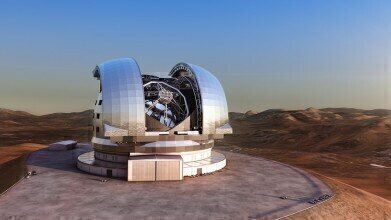-
 An artist impression of the E-ELT (Credit: ESO)
An artist impression of the E-ELT (Credit: ESO)
News & Views
UK Scientists Seal Deal on E-ELT Spectrograph
Oct 20 2015
UK researchers have signed an agreement to lead one of the first instruments for what will become the World’s largest visible and infrared telescope, the European Extremely Large Telescope (E-ELT). The spectrograph, called HARMONI, to be led by University of Oxford and STFC’s UK Astronomy Technology Centre, will provide the European Southern Observatory (ESO)’s telescope with a sensitivity that is up to hundreds of times better than any current telescope of its kind. The agreement was signed at a ceremony in Oxford.
Perched on top of Cerro Armazones in the Atacama Desert of northern Chile, the E-ELT will have a giant main mirror 39 metres in diameter. It is one of the biggest global science collaborations in history and includes an £88 million investment by the UK government. UK industry has already won over £10 million worth of contracts from the E-ELT in advance of HARMONI and that figure is expected to at least match the UK government’s investment by the time construction is complete.
The HARMONI instrument will be especially powerful in that it combines imaging and spectroscopy using a technique called ‘integral field spectroscopy’. This enables spectra of many positions in a galaxy (for instance) to be measured simultaneously The telescope will enable scientists to see more distant objects than previously possible, allowing them to understand younger structures in our night sky than ever before — helping improve our understanding of the Universe, the effects of dark matter and energy and planets outside of our solar system.
In its early days, the E-ELT will be equipped with three scientific instruments; two first light instruments, a camera (MICADO) and a spectrograph (HARMONI), followed soon after by the mid-infrared instrument (METIS).
The HARMONI instrument will observe an astronomical object in three dimensions simultaneously, with spatial information in two dimensions and wavelength in the third.
The project is led by Professor Niranjan Thatte from the University of Oxford in collaboration with the Science and Technology Facilities Councils’ UK Astronomy Technology Centre, Edinburgh.
Digital Edition
Lab Asia 31.2 April 2024
April 2024
In This Edition Chromatography Articles - Approaches to troubleshooting an SPE method for the analysis of oligonucleotides (pt i) - High-precision liquid flow processes demand full fluidic c...
View all digital editions
Events
Apr 28 2024 Montreal, Quebec, Canada
May 05 2024 Seville, Spain
InformEx Zone at CPhl North America
May 07 2024 Pennsylvania, PA, USA
May 14 2024 Oklahoma City, OK, USA
May 15 2024 Birmingham, UK





.jpg)











